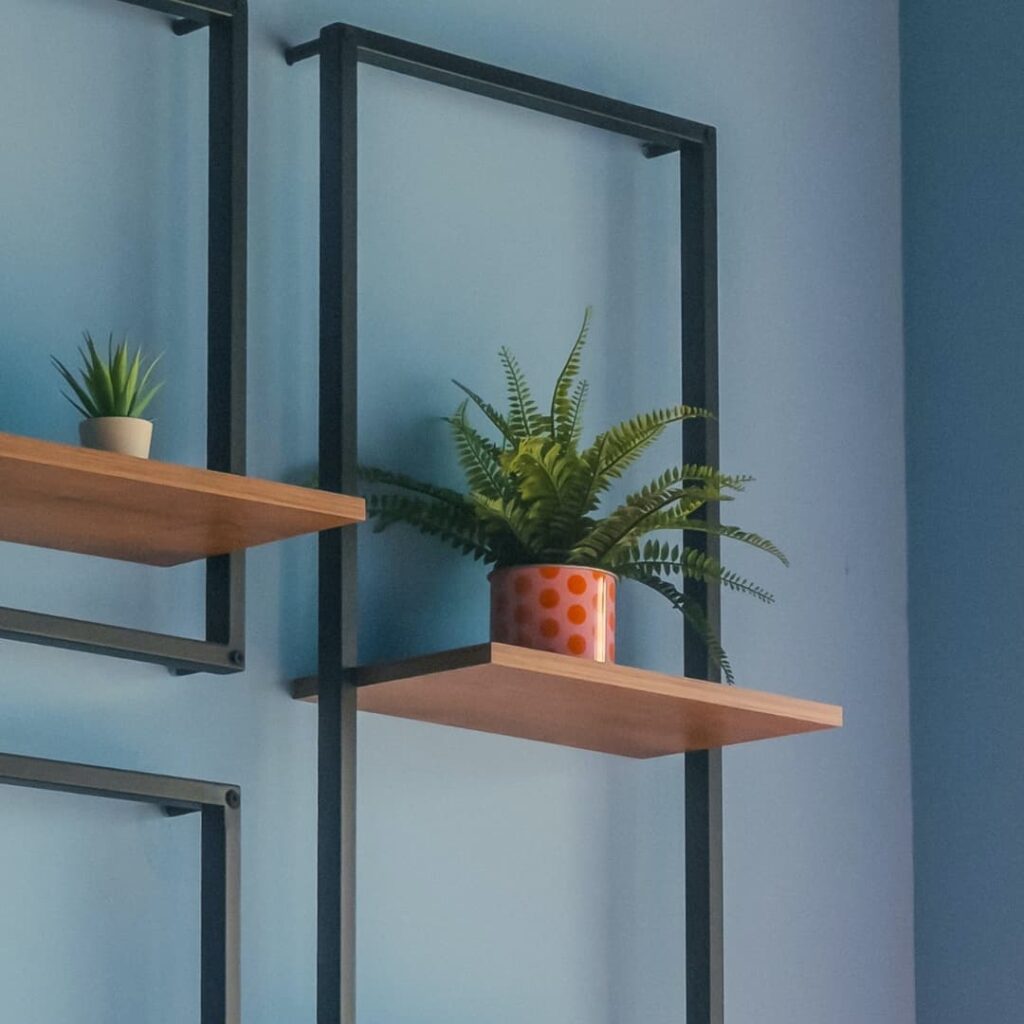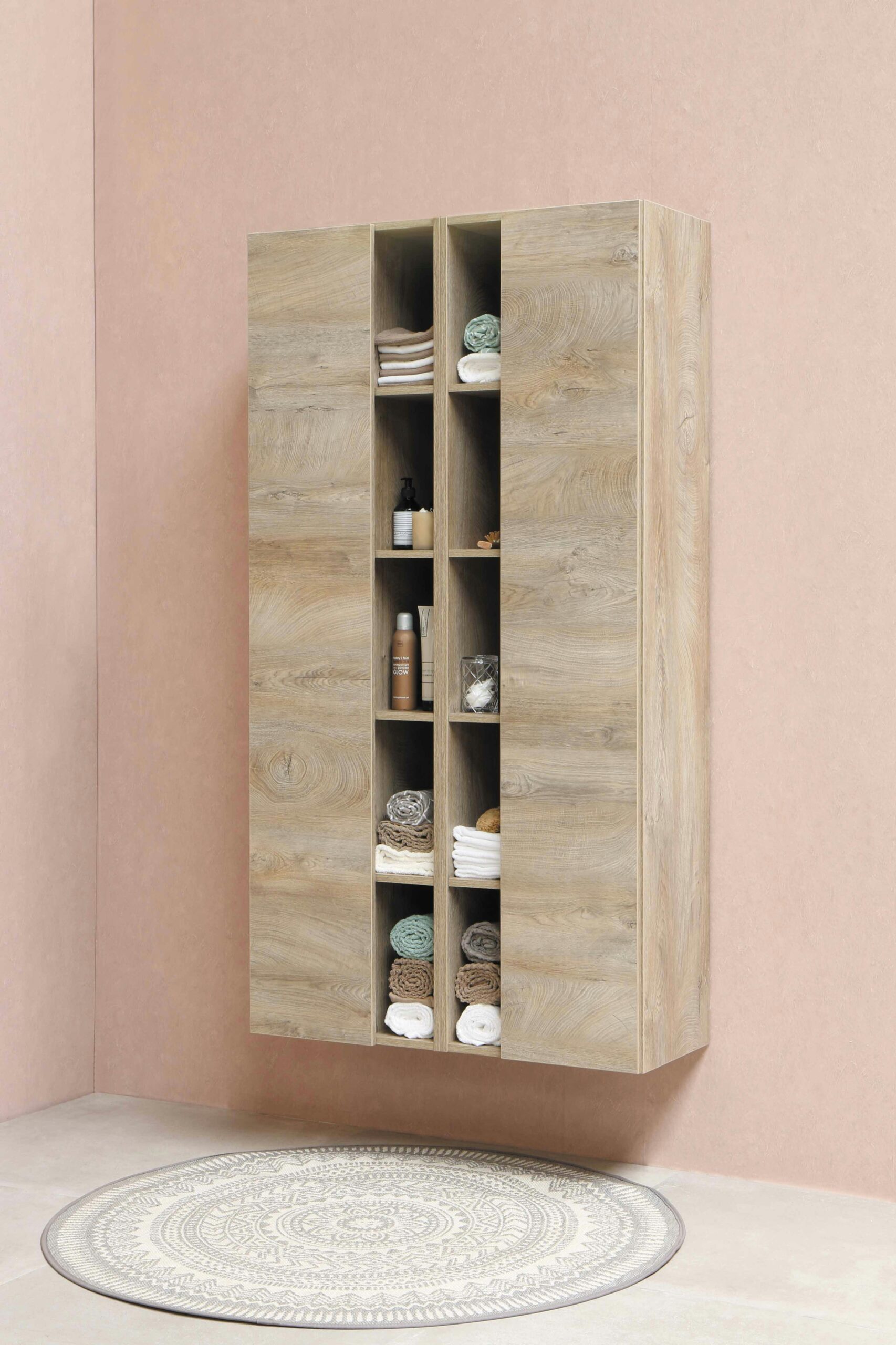Introduction to Wall Shelves
Wall shelves have become an integral part of modern home décor, serving as functional and aesthetic elements within various living spaces. These versatile fixtures not only provide additional storage but also play a significant role in maximizing available space, making them particularly beneficial in smaller homes or apartments. By utilizing wall-mounted shelves, homeowners can keep their floors clear while effectively using vertical space, thereby creating a more open and spacious environment.

One of the primary benefits of wall shelves is their ability to showcase personal style. Available in an array of materials, colours, and designs, they can complement any interior theme, whether it be contemporary, rustic, or minimalist. From floating shelves to more traditional bracket-mounted options, the variety of styles allows individuals to express their unique tastes through curated displays of books, decorative objects, and plants. This personalized touch not only enhances the visual appeal of a room but also adds a sense of individuality to the home.
Additionally, wall shelves contribute significantly to organizational efforts within the home. They provide a practical solution for reducing clutter by offering designated spaces for items that might otherwise occupy valuable surface areas. As a result, wall shelves can make everyday items easily accessible while maintaining an orderly appearance. This feature is particularly useful in high-traffic areas, where keeping items within reach yet out of the way is essential for smooth daily routines.
In summary, wall shelves are more than mere storage solutions; they serve as important design components that can elevate the aesthetic quality of any home. As we delve deeper into the world of wall shelves, we will explore the various types available, along with their specific applications and benefits in home design.
Types of Wall Shelves
Wall shelves come in various styles, each designed to meet distinct needs and aesthetic preferences. Understanding the different types available can simplify the selection process for home decorating enthusiasts. Here are some of the most popular types of wall shelves:
Floating shelves are arguably the most contemporary option. These shelves are anchored directly to the wall, creating a seamless appearance that appears to ‘float’ without visible brackets. Their minimalist design makes them an excellent choice for modern interiors, allowing homeowners to display decorative items or books without overwhelming the space. Floating shelves come in a variety of materials, such as wood, glass, or metal, making them versatile for any decor style.
Corner shelves are specifically designed to optimize often unused corner spaces in a room. These shelves typically feature triangular or curved designs that fit snugly into corners, maximizing storage while adding visual interest. Corner shelves are ideal for small spaces or for creating unique display areas for plants, collectables, or photographs.
Bracketed shelves offer a more traditional approach, utilizing visible brackets for support. This design allows for increased weight capacity, making them suitable for heavier items or books. They are available in various styles, from rustic wooden brackets to sleek metal options, catering to a range of tastes and home aesthetics. Bracketed shelves can be mounted in any room, providing both functional storage and decorative elements.
Modular shelving systems represent a flexible choice for homeowners seeking to customize their storage solutions. These can be configured in various arrangements and often include components such as shelves, cubbies, and hooks. Suitable for home offices, playrooms, or living areas, these systems can evolve with changing needs, accommodating shifting storage requirements over time.
Each type of wall shelf serves a unique purpose, and selecting the right one can significantly enhance both functionality and style in any home. Carefully considering these options will guide readers to make informed decisions that align with their needs and home decor preferences.
Materials Used in Wall Shelves
Wall shelves are versatile storage and decor solutions that can enhance any room’s aesthetic. Various materials are used in the construction of wall shelves, each offering unique benefits and drawbacks. Understanding these materials is essential for selecting the best option that aligns with your home decor style and functional needs.
Wood is one of the most popular choices for wall shelves, providing warmth and a sense of natural beauty. It comes in numerous species, from oak and walnut to pine and maple. Wooden shelves are generally durable and can support substantial weight, making them ideal for books and decorative items. However, they require regular maintenance, such as polishing and sealing, to prevent damage from humidity or pests. Additionally, solid wood can be costly compared to other materials.
Metal shelves are recognized for their strength and modern appeal, often suitable for industrial and contemporary settings. Metals such as steel, aluminum, and iron are utilized to create sturdy shelves that can hold heavy items. They are usually resistant to moisture and easy to clean, requiring minimal maintenance. However, metal can be prone to corrosion if not treated properly, and its aesthetic may not fit traditional decor styles.
Glass shelves offer a sleek, lightweight option for displaying decorative pieces, and they contribute to an airy and open feel in a space. Their transparency can enhance a room’s aesthetics, allowing for more visual flow; however, they may not provide the weight capacity that heavier items require. Moreover, glass shelves necessitate careful handling to avoid breakage and regular cleaning to remove fingerprints and dust.
Composite materials, often a combination of wood fibers and resin, provide a budget-friendly alternative to natural wood and can mimic its appearance. These shelves are relatively lightweight and easy to install, making them suitable for various decor styles. However, they may not be as durable or long-lasting as solid wood or metal options, and their weight capacity can be limited depending on the specific product.
Each material presents distinct advantages and disadvantages, allowing homeowners to make informed choices based on their specific aesthetic preferences and functional requirements.
How to Choose the Right Wall Shelf
Selecting the right wall shelf for your home involves a careful consideration of several factors, ensuring that the finished result is both functional and aesthetically pleasing. One of the primary aspects to evaluate is the size of the wall shelf you intend to install. Accurate measurements of both the shelf and the intended wall space are essential. It is advisable to measure not only the width and height of the area but also the depth, especially if you plan to display books or other items. A shelf that is too large can overpower a room, while one that is too small may not effectively utilize the available space.
Another crucial factor is the load-bearing capacity of the wall shelf. It is important to consider the weight of the items you wish to store. Heavier items such as books or decorative pieces require sturdy shelves, so materials made from solid wood or metal are often preferable. Be sure to check the manufacturer’s specifications for load limits to ensure your chosen shelf can handle the intended weight without risk.
The style and color of the wall shelf also play a significant role in your selection process. Consider the existing décor of your room: a modern space may call for sleek, minimalist shelves, while a more traditional setting might benefit from ornate designs. Additionally, the color scheme of your room should guide your choice; shelves should either complement or contrast with existing colors in a harmonious way.
Lastly, assessing wall space can lead to better choices. Ensure that you leave adequate space around the shelf for items and consider accessibility when placing the shelf at different heights. By contemplating these aspects, you empower yourself to make informed decisions, leading to a satisfying addition to your home decor.
Top Wall Shelf Designs for Every Room
Wall shelves are an excellent way to enhance both the functionality and aesthetic appeal of any room in your home. With a vast array of designs available, each can serve different purposes while adding unique character to your space. This section explores the top wall shelf designs suitable for various rooms, including living rooms, kitchens, bathrooms, and bedrooms, along with styling tips to optimize their look and functionality.
In the living room, floating shelves are a timeless choice that can be used to display books, photographs, or decorative items. These shelves create a clean look and can be styled with clusters of items to draw the eye. For a more artistic touch, consider asymmetrical shelving units that add an element of surprise and creativity. Incorporating plants or sculptures between books can make the arrangement more visually appealing.
In the kitchen, open shelves are increasingly popular for showcasing dishware or cookbooks. Utilizing shelving with hooks can also be beneficial for hanging utensils or pots, combining practicality with a warm, inviting vibe. Opt for wooden shelves to complement rustic themes or metal shelves for a contemporary look. Accessories like colorful plates or curated spice arrangements can enhance the overall kitchen decor.
For bathrooms, minimalist wall shelves can efficiently store toiletries while adding style. The use of glass or wood in natural tones can create a serene ambiance. Adding small potted plants or decorative trays can keep the look neat and cohesive. Make sure to consider moisture resistance when selecting materials for bathroom shelves.
Finally, in bedrooms, wall shelves can be used to highlight personal style. A bedside shelf or a series of staggered shelves can serve as a functional alternative to nightstands. Style them with books, framed photos, and small decorative elements for a personal touch. Each of these wall shelf designs not only maximizes space but also plays a vital role in enhancing the aesthetic of your home.
DIY Shelf Ideas and Inspiration
Creating your own wall shelves provides an opportunity to express your personal style while adding functional decor to your home. DIY shelving not only allows for customization but also enables the use of unconventional materials, which can result in unique and creative designs. To get started, consider the purpose of your shelves—whether for displaying books, plants, or decorative items—and choose your design accordingly. Here are a few inspiring ideas to spark your creativity.
One popular technique is constructing floating shelves, which create the illusion of your items effortlessly levitating against the wall. To make these shelves, all you need are some shelves, brackets, and screws. Start by measuring and marking the position of the brackets on the wall, ensuring they are level. Cut the shelves to your desired length and attach the brackets securely. Floating shelves are particularly effective in smaller spaces, as they save floor room while still providing ample display area.
Another great idea is to repurpose wooden crates into wall shelves. This approach adds a rustic charm to your decor. Simply sand down the crates for a smooth finish, paint or stain them to suit your space, and mount them on the wall either vertically or horizontally. You can stack multiple crates for added storage or arrange them in a varied pattern to create visual interest.
If you’re feeling adventurous, consider using pipes and wooden planks to create industrial-style shelves. This design incorporates materials like metal pipes that can easily be attached to the wall, with wooden planks resting atop them. This not only adds a contemporary touch to your room but also ensures a sturdy shelf capable of holding heavier items.
In addition to these ideas, remember that incorporating personal touches can enhance the overall aesthetic of your DIY shelves. Utilizing unique materials or shapes can make a simple shelf into a statement piece. Any DIY shelving project can be adapted to reflect your taste, ensuring that your wall shelves are as distinctive as they are functional.
Maintaining Your Wall Shelves
Proper maintenance of wall shelves is essential to ensure they remain functional and visually appealing over time. Regular cleaning is a fundamental aspect of shelf care. For most shelving materials, a soft, damp cloth can effectively remove dust and debris without causing damage. It is advisable to follow up with a dry cloth to prevent moisture buildup, which could lead to warping or other damaging effects. For wooden shelves, occasional polishing with a suitable furniture polish can enhance their appearance, while adding a layer of protection against potential scratches.
Preventing warping or sagging is crucial for maintaining the structural integrity of your wall shelves. Several factors contribute to these issues, such as excessive weight, humidity, and temperature fluctuations. To avoid sagging, distribute weight evenly across the shelves and refrain from placing excessively heavy objects on them. It is recommended to frequently reassess the weight load, particularly if the shelves are used for ornamental purposes rather than storage. Should you notice any signs of warping or instability, consider removing items from the shelf and reassessing the mounting brackets or hardware used to install them.
Assessing wall shelves for safety is another vital maintenance task. Regularly inspect brackets and supports to ensure they remain secure and free from corrosion or rust, especially in areas with high humidity. Any signs of deterioration, looseness, or structural failure should prompt immediate action, either through tightening screws or replacing damaged components. Ultimately, committing to a routine maintenance schedule, which includes cleaning, weight assessment, and security checks, will prolong the life and aesthetic quality of your wall shelves, ensuring they serve their intended purpose effectively.
Common Mistakes to Avoid When Installing Wall Shelves
Installing wall shelves can be an excellent way to enhance a home’s decor, offering both functionality and aesthetic appeal. However, several common mistakes can undermine the effectiveness of these installations, potentially leading to undesirable outcomes. One critical pitfall is misjudging the weight load limits of the shelves. It is essential to select shelves that can handle the intended weight of the items to be displayed. Ignoring manufacturer guidelines regarding weight capacity can lead to unsightly accidents, where shelves break or items fall, resulting in both damage and potential injury.
Another frequent error is improper spacing between shelves. When planning your installation, consider the size of the items that will be placed on each shelf. Shelves that are too close together may limit the height for placing items, while those spaced too far apart may create a chaotic look. A well-thought-out arrangement that considers both functionality and visual harmony will enhance the overall design of your room. Additionally, spacing should also relate to the room’s scale; larger items may necessitate wider spacing.
Choosing unsuitable locations for your wall shelves is another common mistake. Shelves should not only be placed where they fit but should also complement the room’s layout and design. Avoid high-traffic areas where items might be knocked over or damaged. Instead, opt for spaces that enhance the room’s aesthetic, such as above furniture or in areas that are easily accessible yet visually appealing. Before installation, it’s wise to visualize or mock-up your arrangement to ensure that it works well with the existing decor.
By avoiding these common pitfalls, one can achieve a more secure, functional, and visually pleasing wall shelf installation that adds to the home’s decor.
Conclusion and Final Thoughts
In conclusion, selecting the best wall shelves for home decorating is a multifaceted process that significantly impacts the aesthetic and functionality of your living space. As we have discussed, wall shelves come in various styles, materials, and configurations, offering an array of options to suit diverse tastes and requirements. From floating shelves that create a minimalist appeal to rustic designs that add warmth, the choices are abundant, allowing homeowners to enhance their décor in unique ways.
When choosing wall shelves, it is essential to consider factors such as the intended use, the room’s overall design, and the scale of the items to be displayed. For instance, while heavy-duty shelves may be perfect for books and collectibles, lighter options could suffice for decorative pieces and plants. Additionally, the variety of colors and finishes available further enables individuals to make selections that complement existing furnishings and color schemes, thereby achieving a cohesive look throughout the home.
Moreover, wall shelves are not only practical; they also provide an excellent canvas for creativity. Homeowners are encouraged to think outside the box when it comes to utilizing wall space. Incorporating different shelf heights, layering textures, and mixing materials can lead to a visually appealing display that reflects personal style. Remember, your approach to organizing and showcasing items can dramatically influence the ambiance of a room, transforming it from ordinary to extraordinary.
As you embark on this journey of selecting and arranging wall shelves, we hope you feel inspired to experiment with your creativity. Share your favorite wall shelf styles or unique decorating ideas with us, as your insights could motivate others looking to enhance their own living spaces. The possibilities are endless, and with thoughtful choices, your wall shelves can indeed become an integral part of your home décor.
Amazon Affiliate Disclosure: As an Amazon Associate, I earn from qualifying purchases. This means I may receive a small commission if you purchase through my links at no extra cost to you.
















